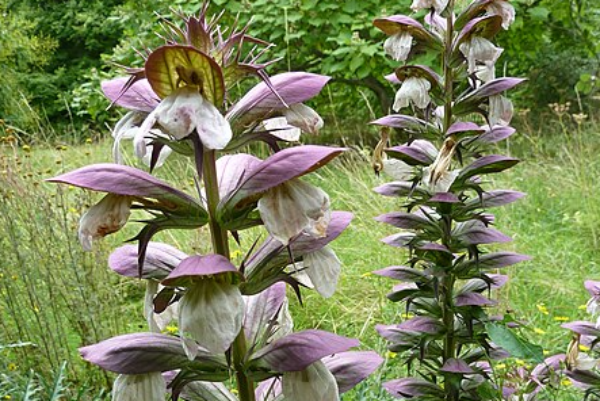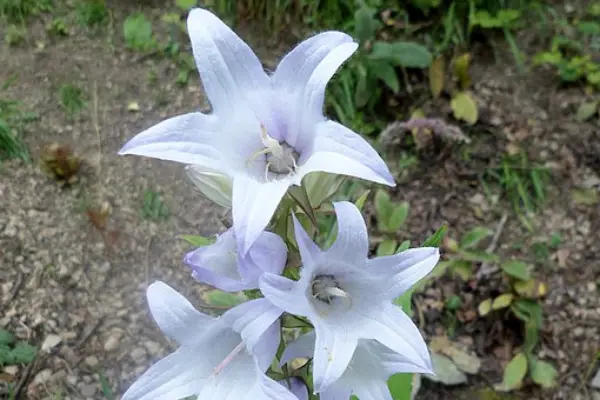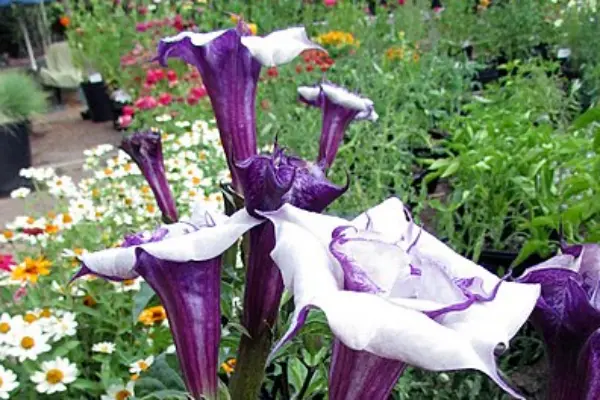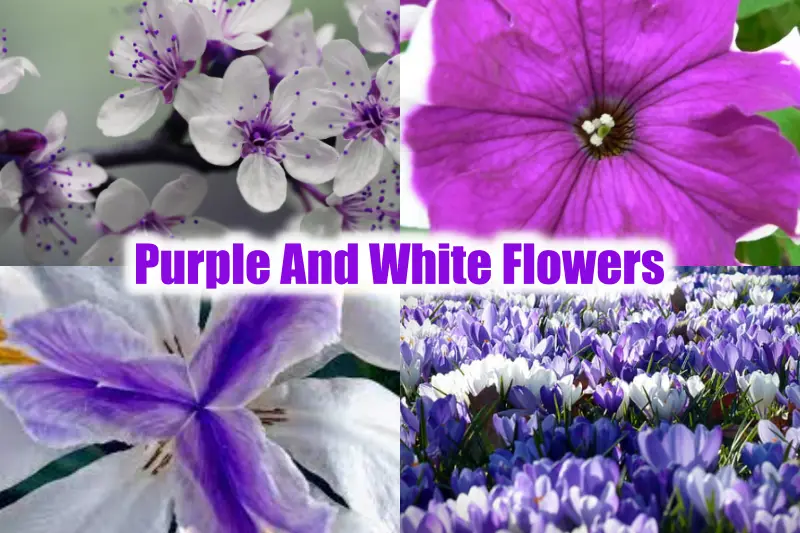Earth has a lot of beautiful views, and most commonly, what we all love to see is gardens of flowers. Whatever we think to make in scenery and landscape, we never forget to make a flower in it. We all love flowers. As flowers give freshness to all of us, their smell is awesome, and here we are going to observe some species of purple and white flowers that you can grow in your garden or backyard. Yes, purple and white flowers really exist in the world.
If you want to know about them, then let’s go into the world of beautiful flowers.
20 Purple And White Flowers:
1) Bear’s breeches

| Scientific name | Acanthus mollis |
| Size | ~200 cm |
| Identification | purple sepals look like lip flowers upper and lower lip |
Acanthus mollis, also known as bear’s breeches, sea dock, bear’s foot plant, sea holly, gator plant, or oyster plant, is a Mediterranean-native perennial herb with tuberous roots.
Its rosette of large, lobed, or toothed leaves is 50 cm long and 30 cm wide on a petiole 20-30 cm long. The flowers are borne on an erect spike up to 200 cm tall.
The sepals are purplish and function as the upper and lower lips of the petals, with the upper lip being 4 cm long and the lower lip being 3 cm long.
Do you know petals form a tube with a ring of hairs where the stamens are attached? The fruit is a sharply-pointed capsule about 2 cm long, containing one or two brown seeds.
2) Giant Bellflower

| Scientific name | Campanula latifolia |
| Size | 60-120 cm |
| Identification | five violet petals |
Campanula latifolia, also known as the giant bellflower, is a species of bellflower native to Europe and western Asia. It is a clump-forming perennial herbaceous plant that grows up to 60 to 120 centimeters tall.
The stem is unbranched, erect, and pubescent. The basal leaves are broadly ovate with a heart-shaped base.
The inflorescence is a many-flowered terminal raceme or in the axils of upper leaves with subtending bracts. The flowers are hermaphrodite, bell-shaped, and 35 to 60 mm long.
The calyx is fused with five narrow lobes, and the corolla is pubescent with five dark violet-blue fused petals.
The fruit is a hairy, nodding capsule, and the flowering period is from July to September.
3) Datura Blackcurrant Swirl

| Scientific name | Datura metel |
| Size | ~182 cm |
| Identification | green or purple-black stems |
Datura Blackcurrant Swirl is a cultivar of Datura metel, known for its polished-looking ebony-black stem and deep purple exterior. The plant has become naturalized in Israel. If you visit Israel you will be amazed to see that it is used as a roadside dweller, similar to its white-flowered ancestor.
Datura metel is a shrub-like annual or short-lived perennial, known in Europe as Indian thornapple, Hindu Datura, or metel, and in the United States as devil’s trumpet or angel’s trumpet.
The plant can grow up to 6 ft high, with hollow, green, or purple-black stems and a strong odor. The flowers are pleasantly scented and can be single or double, with corolla colors ranging from white to cream, yellow, red, and violet.
4) Jamaican forget-me-not
| Scientific name | Browallia Americana |
| Size | 12-20 cm |
| Identification | inner part of the petals are white |
Browallia Americana, also known as the Jamaican forget-me-not, amethyst flower, or bush violet, is a flowering plant native to tropical Latin America.
The plant produces star-shaped, sky-blue, or violet color flowers with a cream or off-white center, blooming heavily until the first frost.
It is popular with butterflies and bees. Means you will have a lot of butterflies in your garden or backyard.
5) Petunia × atkinsiana
| Scientific name | Petunia × atkinsiana |
| Size | ~10 cm |
| Identification | purple and white petals with yellow centers |
Petunia × atkinsiana is a hybrid petunia plant nothospecies, consisting of hybrid species between P. axillaris and P. integrifolia. Most petunias sold for home gardens belong to these nothospecies.
P. axillaris produces night-fragrant, buff-white blossoms with long, thin tubes and flattened openings. The plant has a beautiful combination of purple and white petals with yellow centers.
6) Garden candytuft
| Scientific name | Iberis umbellata |
| Size | 30-50 cm |
| Identification | umbel-shaped corymbs |
Iberis umbellata, also known as garden candytuft or globe candytuft, is a herbaceous annual flowering plant in the Brassicaceae family. Its biological form is hemicryptophyte scapose, with overwintering buds below the soil surface and an erect floral axis.
The flowers are in umbel-shaped corymbs, with violet calyx and four white, pink, or purple petals. We assure you that if you put these flowers in your backyard or garden there will be beautiful butterflies.
7) Alpine clematis
| Scientific name | Clematis alpina |
| Size | 20-50 cm |
| Identification | purple petals |
Clematis alpina, also known as the Alpine clematis, is a deciduous vine prized for its showy flowers. Originating in Europe, it grows best in American Horticultural Society zones 9 to 6, typically found in southern America. Its cultivars include pale pink ‘Willy’, dark blue ‘Helsingborg’, and lavender blue ‘Pamela Jackman’.
8) Swamp leather-flower
| Scientific name | Clematis crispa |
| Size | 15-25 cm |
| Identification | purple and white color petals |
Swamp leather-flower is a climbing or trailing perennial vine with pinkish-purple, mildly fragrant flowers.
Its flowers are solitary and born on naked, angled stems, with thin, undulate sepal margins. The plant occurs naturally in floodplain forests, wet hammocks, and riverine swamps, and typically blooms in spring and summer.
9) Variegated Monkshood
| Scientific name | Aconitum variegatum |
| Size | 30-90 cm |
| Identification | patches or streaks on petals |
The variegated Monkshood, also known as Devil’s Helm, is a perennial herbaceous plant with an erect, glabrous, or pubescent stem. It is a rhizomatous geophyte, producing roots and aerial stems annually.
The flowers are merged in paniculate inflorescences, zigzaggy ramified, and are light blue or violet with paler striations.
The flower has five tepals, one of which forms a convex, compressed helmet. The corolla is reduced and visible only after moving the helmet, showing two nectarine and six filamentous elements.
10) Fremont’s leather flower
| Scientific name | Aconitum variegatum |
| Size | ~70 cm |
| Identification | inner side is white and the outer side is violet |
Fremont’s leather flower is a species of flowering plant in the buttercup family, found in the United States, known from disjunct populations in central and southeastern states.
It is also known as Fremont’s crowsfoot, leatherplant, and rattleweed. The plant produces hairy stems up to 70 cm tall, with oval leaves up to 14 cm long and 11 cm wide.
Its inflorescence is a single urn-shaped flower with hairy lance-shaped sepals and greenish tips.
11) Broadleaved lavender
| Scientific name | Lavandula latifolia |
| Size | 30-80 cm |
| Identification | longer and wider leaves |
Lavandula latifolia, also known as broadleaved lavender, spike lavender, aspic lavender, or Portuguese lavender, is a flowering plant native to the western Mediterranean region.
It is a strongly aromatic shrub with evergreen leaves and pale lilac flowers produced on spikes 2-5 cm long at the top of slender stems.
The fruit is a nut, indehiscent monosperm of hardened pericarp, consisting of 4 small nuts that often remain locked inside the calyx tube.
12) Dwarf columbine
| Scientific name | Aquilegia saximontana |
| Size | 45-76 cm |
| Identification | inner petal’s outer side is white |
Dwarf Columbine, native to Europe, is found in mountain pastures, rocky places, slopes, and woods. Its small, drooping flowers have hooked spurs and come in a wide range of colors.
Aquilegia saximontana, also known as the Rocky Mountain columbine, is a perennial plant native to the Rocky Mountains in Colorado, United States. It blooms in July and August, with lavender or purple and white flowers.
13) Lesser periwinkle
| Scientific name | Vinca minor |
| Size | 10-15 cm |
| Identification | the inner part of the petals are white with a purple patch altogether making a star shape |
Vinca minor is a trailing subshrub, spreading along the ground and rooting along the stems to form large clonal colonies. The leaves are evergreen, glossy dark green, and leathery with a leathery texture.
The flowers are solitary in the leaf axils and are produced mainly from early spring to mid-summer. They are violet-purple, 2-3 cm in diameter, with a five-lobed corolla.
14) Bigleaf periwinkle
| Scientific name | Vinca major |
| Size | ~25 cm |
| Identification | heart shaped petals |
Vinca major is also known as bigleaf periwinkle, large periwinkle, greater periwinkle, or blue periwinkle. It grows to 25 cm tall and spreads indefinitely, making it an evergreen perennial.
Vinca major is a trailing vine, spreading along the ground and rooting along the stems to form dense masses of groundcover. The flowers are hermaphrodite, axillary, and solitary, violet-purple, 3-5 cm in diameter, with a five-lobed corolla.
15) Common foxglove
| Scientific name | Digitalis purpurea |
| Size | 90-150 cm |
| Identification | conical shape flower |
Digitalis purpurea, also known as the foxglove or common foxglove, is a toxic flowering plant native to temperate Europe and naturalized in North America. But being toxic it doesn’t mean we forget its medical benefits.
It is a popular garden plant with many cultivars and is the original source of the heart medicine digoxin. The flowering stem develops in the second year, typically 1–2 m tall, and the flowers are arranged in a showy, terminal, elongated cluster.
The flowers are typically purple, but some may be pink, rose, yellow, or white. These purple and white flowers generally grow in early summer.
16) Spotted geranium
| Scientific name | Geranium maculatum |
| Size | ~90 cm |
| Identification | five petals and ten stamens |
Geranium maculatum, also known as wild geranium, spotted geranium, or wood geranium, is a perennial plant native to eastern North America.
Its flowers, 2.5-4 cm in diameter, have five petals and ten stamens. They appear in the Northern Hemisphere from April to June and are grouped in loose corymbs or umbels at the top of the stems.
17) Geranium renardii
| Scientific name | Geranium renardii |
| Size | 15-30 cm |
| Identification | white petals with purple color streaks |
Geranium renardii is also a purple and white flower species native to regions between Europe and Asia. It grows up to 30 cm tall and broad, with palmate leaves and pale pink flowers striped violet.
Geranium renardii is a dense, clump-forming perennial with scalloped, felted, wrinkled, long-petioled, gray-green basal leaves. Its attractive leaves turn yellow in fall, and its five-petaled, pale mauve to white flowers bloom in late spring to early summer.
18) Summer lilac
| Scientific name | Buddleja davidii |
| Size | ~500 cm |
| Identification | pale brown bark |
Summer lilica is scientifically known as Buddleja davidii. You might know it through other names butterfly-bush or orange eye. It is widely used as an ornamental plant.
Furthermore, these purple and white flowers have many named varieties in cultivation. It is a vigorous shrub with an arching habit, growing up to 5 meters tall. The pale brown bark becomes deeply fissured with age, and the branches are quadrangular in section.
19) Clematis Venosa Violacea
| Scientific name | Venosa Violacea |
| Size | 180-400 cm |
| Identification | prominent white stripe and purple stamens |
Clematis Venosa Violacea is a full-gallon size vining plant with 4-inch purple and white flowers with distinctive purple veins. It blooms from midsummer to early fall and is ideal for trellises or arbors.
With a 10-foot length, it produces new flowers until late fall.
20) Branched monkshood
| Scientific name | Aconitum degenii |
| Size | 20-25 cm |
| Identification | upper petal is longer than others |
Aconitum degenii is a branched monkhood, a tall, spindly, and erect perennial plant in the buttercup family. The inflorescence is paniculate and branched, with blue or purple perigon and a curved stem.
The plant reaches a height of 0.5 to 2.5 meters and pollinates with insects. Its pod-like follicles produce pod-like fruits. However, it is poisonous due to the presence of alkaloids like aconitine.
Conclusion:
These are some of the purple and white flowers that will definitely make you feel high, as their smell and view in your garden or backyard will make you dream like you are in heaven. If you want to know more about these flowers and some other flowers, then keep looking for them with us on HowItSee.
Reference:
- Wikipedia
- Plant identifier
- Gardeners world

As a content writer, I like to write about different niches. I have a curiosity about nature and animals. And like to learn about them. Through my writing, I like to share my experience and knowledge with you. I hope you are enjoying it too.

